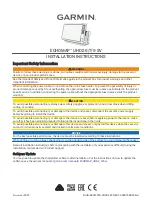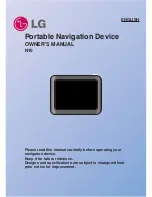
6-2
SL520/530/631 PLUS Chartplotter Displays
Pl
an
ni
ng t
he
Inst
alla
tio
n
For full functionality of the chartplotter you need to provide position and
heading data.
•
Orientation - heading data is required for chart to operate in Course Up and
Head Up.
•
MOB requires heading and speed data. Alternatively, SOG and COG
(derived from the same source as position data) enable the MOB function.
•
Position data is required for full functionality of the chart display.
Full details of heading, position and other data are given in
Section 6.8.
Planning the Installation
Before you install your system, plan the installation, considering:
•
Location of the display unit, as described in
Section 6.3
.
•
Cable Runs, including cables for an integrated system (to provide heading
and position data etc.), as described in
Section 6.4
.
EMC Installation Guidelines
All Raymarine equipment and accessories are designed to the best industry
standards for use in the recreational marine environment.
Their design and manufacture conforms to the appropriate Electromagnetic
Compatibility (EMC) standards, but correct installation is required to ensure
that performance is not compromised. Although every effort has been taken to
ensure that they will perform under all conditions, it is important to understand
what factors could affect the operation of the product.
The guidelines given here describe the conditions for optimum EMC
performance, but it is recognized that it may not be possible to meet all of these
conditions in all situations. To ensure the best possible conditions for EMC
performance within the constraints imposed by any location, always ensure
the maximum separation possible between different items of electrical
equipment.
For
optimum
EMC performance, it is recommended that
wherever possible
:
•
Raymarine equipment and cables connected to it are:
•
At least 3 ft (1 m) from any equipment transmitting or cables carrying
radio signals e.g. VHF radios, cables and antennas. In the case of SSB
radios, the distance should be increased to 7 ft (2 m).
•
More than 7 ft (2 m) from the path of a radar beam. A radar beam can
normally be assumed to spread 20 degrees above and below the radiat-
ing element.
Summary of Contents for 530
Page 2: ......
Page 12: ...xii SL520 530 631 PLUS Chartplotter Displays...
Page 48: ...2 24 SL520 530 631 PLUS Chartplotter Displays Review Your Passage Plan...
Page 90: ...3 42 SL520 530 631 PLUS Chartplotter Displays SmartRoute...
Page 102: ...4 12 SL520 530 631 PLUS Chartplotter Displays Data Log Mode...
Page 146: ...7 6 SL520 530 631 PLUS Chartplotter Displays Worldwide Support...
Page 150: ...A 4 SL520 530 631 PLUS Chartplotter Displays SL520 530 631 PLUS Displays...
Page 156: ...B 6 SL520 530 631 PLUS Chartplotter Displays C MAP Chart Card Features...
Page 170: ......
















































